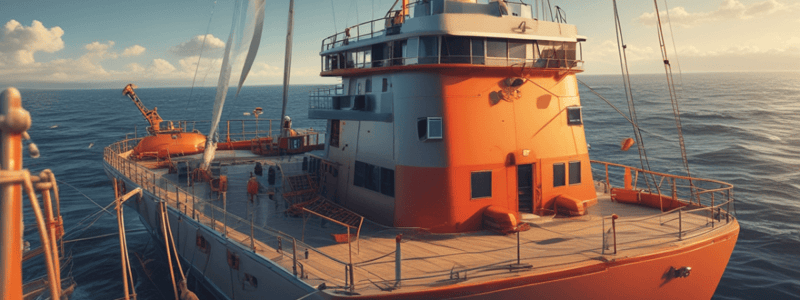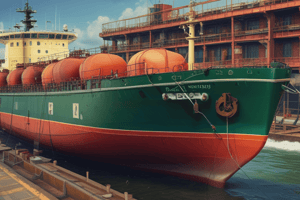Podcast
Questions and Answers
What is the purpose of the sea water inlet valve on the bilge pump?
What is the purpose of the sea water inlet valve on the bilge pump?
The sea water inlet valve on the bilge pump allows seawater to be used to operate the bilge pump.
What is the purpose of the air release on the separator shell?
What is the purpose of the air release on the separator shell?
The air release on the separator shell allows air to be released from the separator, preventing air pockets from forming.
What is the purpose of the oil content monitor on the overboard discharge?
What is the purpose of the oil content monitor on the overboard discharge?
The oil content monitor on the overboard discharge measures the oil content of the water being discharged overboard to ensure it meets environmental regulations.
What is the purpose of the baffle plates inside the separator shell?
What is the purpose of the baffle plates inside the separator shell?
What is the purpose of the relief valve on the separator shell?
What is the purpose of the relief valve on the separator shell?
What conditions must be present for microbes to live and multiply in marine gas oil?
What conditions must be present for microbes to live and multiply in marine gas oil?
What is the effect of microbiological growth in the fuel?
What is the effect of microbiological growth in the fuel?
How can microbiological contamination in marine gas oil be detected?
How can microbiological contamination in marine gas oil be detected?
How can the risk of microbiological contamination in marine gas oil be reduced?
How can the risk of microbiological contamination in marine gas oil be reduced?
How can microbiological contamination in marine gas oil be removed?
How can microbiological contamination in marine gas oil be removed?
What are the recommended maximum periods of time for personnel employed on watchkeeping duties within enclosed machinery spaces, and why have these recommendations been made?
What are the recommended maximum periods of time for personnel employed on watchkeeping duties within enclosed machinery spaces, and why have these recommendations been made?
At what noise levels is hearing protection (i) recommended and (ii) mandatory?
At what noise levels is hearing protection (i) recommended and (ii) mandatory?
Explain the importance of following the recommended procedures and checks before switching the Main Propulsion machinery space to UMS (Unmanned Machinery Space) mode.
Explain the importance of following the recommended procedures and checks before switching the Main Propulsion machinery space to UMS (Unmanned Machinery Space) mode.
Describe the potential consequences of prolonged exposure to high noise levels in enclosed machinery spaces, both for personnel and equipment.
Describe the potential consequences of prolonged exposure to high noise levels in enclosed machinery spaces, both for personnel and equipment.
List and briefly explain five essential checks or procedures that should be performed before switching the Main Propulsion machinery space to UMS mode.
List and briefly explain five essential checks or procedures that should be performed before switching the Main Propulsion machinery space to UMS mode.
Describe the potential impact of high noise levels on effective communication and situational awareness in the machinery space, and discuss strategies to mitigate these risks.
Describe the potential impact of high noise levels on effective communication and situational awareness in the machinery space, and discuss strategies to mitigate these risks.
Explain the importance of maintaining accurate and up-to-date records of noise level measurements and personnel exposure in the machinery spaces, and discuss the potential consequences of non-compliance.
Explain the importance of maintaining accurate and up-to-date records of noise level measurements and personnel exposure in the machinery spaces, and discuss the potential consequences of non-compliance.
Describe the role and responsibilities of the engineering watch officer in ensuring the safe and efficient operation of the machinery spaces while in UMS mode, and discuss the potential challenges they may face.
Describe the role and responsibilities of the engineering watch officer in ensuring the safe and efficient operation of the machinery spaces while in UMS mode, and discuss the potential challenges they may face.
Flashcards are hidden until you start studying
Study Notes
Bilge Pumping and Oily Water Separators
- Sea water inlet valve on bilge pump: allows sea water to enter the bilge pump to flush out bilge water
- Air release on separator shell: releases air that may have accumulated in the separator shell
- Oil content monitor on overboard discharge: monitors the oil content in the overboard discharge to ensure it meets regulations
- Baffle plates inside the separator shell: help to separate oil from water by slowing down the flow and allowing gravity to separate the two fluids
- Relief valve on separator shell: releases excess pressure in the separator shell to prevent damage
Microbiological Contamination of Marine Gas Oil
- Conditions for microbial growth: water, temperature, nutrients, and microorganisms must be present
- Effects of microbiological growth: corrosion of tanks and pipes, fuel contamination, and engine problems
- Detection of contamination: through fuel sampling and analysis
- Reducing the risk of contamination: by using biocides, maintaining clean tanks, and monitoring fuel quality
- Removing contamination: through fuel treatment and tank cleaning
Calcium Hypochlorite
- Precautions for use and storage: handle with gloves and goggles, store in a well-ventilated area, and avoid mixing with other chemicals
Sewage Treatment Plant
- Physical properties to monitor: pH, temperature, dissolved oxygen, and biochemical oxygen demand
Environmental Effects
- Green House Effect: a process by which certain gases in the atmosphere trap heat and contribute to global warming
- Ozone depletion: the reduction of ozone in the stratosphere due to the presence of chlorofluorocarbons and other substances
Refrigeration System
- Effect of undercharge: reduced cooling capacity, increased energy consumption, and potential system failure
Micro-organisms in Water
- Types of micro-organisms: bacteria, viruses, and protozoa
Silver Ion Sterilizer
- Operation: uses silver ions to sterilize water by inhibiting microbial growth
Hydraulic Stabilising System
- Active fin hydraulic stabilising operating system: fitted to a vessel to reduce rolling and improve stability
Hydrodynamic Forces
- Forces that act on a vessel: frictional resistance, wave resistance, and air resistance
Certificates of Competency for Engineers
- Examination details: administered by the Scottish Qualifications Authority on behalf of the Maritime and Coastguard Agency
Studying That Suits You
Use AI to generate personalized quizzes and flashcards to suit your learning preferences.




